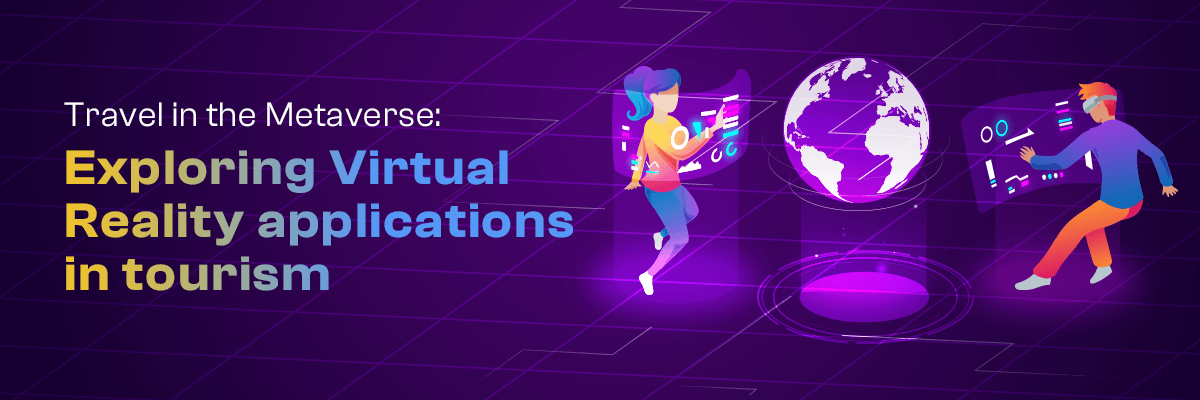Metaverse, or virtual reality, is something people always associate with gaming, but in reality, it has an impact in other sectors too. Even the tourism sector can be totally changed in the upcoming years with the help of virtual reality. In the coming years, it can happen that you will be enjoying the sunset in the hills of Himalaya while sitting in your office in New York.
Why use virtual reality in tourism?
Travel and tourism is one of the fastest-growing economic sectors globally, with 1.5 billion foreign visitors predicted in 2019 and rising to 1.8 billion by 2030. The industry confronts many difficulties, such as rivalry, sustainability, customer happiness, and accessibility. Tourism marketers must come up with creative and practical ways to advertise their places and goods if they are to overcome these obstacles. In this sense, virtual reality can be a very useful tool.
Benefits of VR in tourism
Virtual reality offers several benefits in tourism, including –
1. Reduced Costs: VR experiences can be a cost-effective way to showcase a wider range of destinations compared to traditional fam tours or location scouting trips.
2. Increased Efficiency: VR allows clients to virtually explore multiple destinations during a single appointment, saving valuable time and resources.
3. Improved Customer Engagement: VR creates a more interactive and engaging experience for clients, leading to a more positive and memorable interaction with your agency.
4. Boost Client Confidence: Many travelers, especially those venturing to new destinations, can feel apprehensive. VR allows them to virtually explore a location, alleviating anxieties about unfamiliar surroundings and making them feel more confident about their travel decisions.
Application of VR in tourism
Virtual reality (VR) is a highly beneficial tool in the tourist industry as it allows individuals to have an immersive experience of different destinations without leaving their homes. Here are some examples:
1. Showcase the Destination or Product: With virtual reality or VR, 360 degree images and videos that highlight the charm and beauty of a destination can be produced and then the people can watch it using the VR headset.
2. Interactive Experiences: With the help of VR, immersive simulations can be created which can help the user to feel like they are present in that particular environment. For example, people can sit in a virtual kayak ride through the Grand Canyon while sitting in India or anywhere in the world through VR.
3. Personalized Stories: VR has the potential to produce narratives that cast users as participants or characters. You can just feel like a part of a film happening in Turkey while you are in Chile through VR.
4. Virtual Tours: Using narration, text, video or audio, Virtual Reality can help to provide tours of a location. You can just do a tour of a historic place while the background audio explains the history in detail.
5. Social Interaction: Last but not least, VR can help you to connect and interact socially with different people around the world with the help of VR and you don’t need to travel physically to meet your friends now.
Real-world examples of the use of VR in tourism –
Numerous businesses have already effectively integrated virtual reality into their travel plans. Here are two noteworthy instances:
1. VR Postcards from Marriott: At the London Marriott Park Lane and the New York Marriott, Marriott provided VR headsets to their patrons. The result was a notable increase in visitor satisfaction scores, highlighting VR’s ability to improve the customer experience and promote brand loyalty.
2. Virtual Flights by First Airlines: First Airlines presents a novel travel idea that combines virtual and real-world components. Travelers board an authentic A310 cabin replica and put on virtual reality headsets to see their destination up close while receiving attention from real flight attendants.
Limitations of the use of VR in tourism
There are a few restrictions on the application of virtual reality (VR) in travel. A significant drawback is the absence of tangible sensory encounters. Virtual reality is unable to fully capture the sensory experiences of travel, such as savoring regional food or experiencing the sun’s warmth. Technological and financial obstacles also exist, such as the requirement for functional VR headsets and dependable internet connections. Moreover, VR content is not widely available, especially for less-traveled locations. Finally, there is a chance that an excessive reliance on VR will result in a decrease in real-world travel and the associated cultural and economic advantages.
Redefining Travel Experiences
None of us can predict the future, but one thing we can predict is that it will be much more interesting for human beings because of the immersion of technology in different sectors. Travel and tourism will surely be one of the most important sectors that will benefit from such newly developed technologies.
At Jet2TravelTech, we specialize in innovative travel technology solutions. We can help you leverage the power of VR to create immersive experiences that will transform your travel agency and leave a lasting impression on your clients.
Partner with Jet2TravelTech today and unlock the exciting possibilities of VR in tourism!



